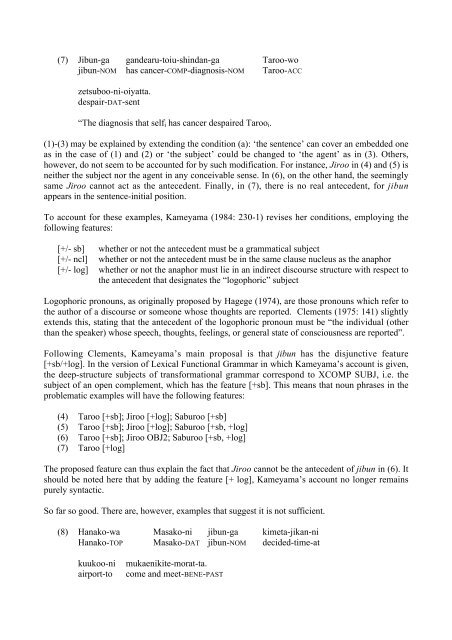SemPrag03.Progr.pdf - Institut für Linguistik/Germanistik - Universität ...
SemPrag03.Progr.pdf - Institut für Linguistik/Germanistik - Universität ...
SemPrag03.Progr.pdf - Institut für Linguistik/Germanistik - Universität ...
Create successful ePaper yourself
Turn your PDF publications into a flip-book with our unique Google optimized e-Paper software.
(7) Jibun-ga gandearu-toiu-shindan-ga Taroo-wo<br />
jibun-NOM has cancer-COMP-diagnosis-NOM Taroo-ACC<br />
zetsuboo-ni-oiyatta.<br />
despair-DAT-sent<br />
“The diagnosis that self i has cancer despaired Taroo i .<br />
(1)-(3) may be explained by extending the condition (a): ‘the sentence’ can cover an embedded one<br />
as in the case of (1) and (2) or ‘the subject’ could be changed to ‘the agent’ as in (3). Others,<br />
however, do not seem to be accounted for by such modification. For instance, Jiroo in (4) and (5) is<br />
neither the subject nor the agent in any conceivable sense. In (6), on the other hand, the seemingly<br />
same Jiroo cannot act as the antecedent. Finally, in (7), there is no real antecedent, for jibun<br />
appears in the sentence-initial position.<br />
To account for these examples, Kameyama (1984: 230-1) revises her conditions, employing the<br />
following features:<br />
[+/- sb] whether or not the antecedent must be a grammatical subject<br />
[+/- ncl] whether or not the antecedent must be in the same clause nucleus as the anaphor<br />
[+/- log] whether or not the anaphor must lie in an indirect discourse structure with respect to<br />
the antecedent that designates the “logophoric” subject<br />
Logophoric pronouns, as originally proposed by Hagege (1974), are those pronouns which refer to<br />
the author of a discourse or someone whose thoughts are reported. Clements (1975: 141) slightly<br />
extends this, stating that the antecedent of the logophoric pronoun must be “the individual (other<br />
than the speaker) whose speech, thoughts, feelings, or general state of consciousness are reported”.<br />
Following Clements, Kameyama’s main proposal is that jibun has the disjunctive feature<br />
[+sb/+log]. In the version of Lexical Functional Grammar in which Kameyama’s account is given,<br />
the deep-structure subjects of transformational grammar correspond to XCOMP SUBJ, i.e. the<br />
subject of an open complement, which has the feature [+sb]. This means that noun phrases in the<br />
problematic examples will have the following features:<br />
(4) Taroo [+sb]; Jiroo [+log]; Saburoo [+sb]<br />
(5) Taroo [+sb]; Jiroo [+log]; Saburoo [+sb, +log]<br />
(6) Taroo [+sb]; Jiroo OBJ2; Saburoo [+sb, +log]<br />
(7) Taroo [+log]<br />
The proposed feature can thus explain the fact that Jiroo cannot be the antecedent of jibun in (6). It<br />
should be noted here that by adding the feature [+ log], Kameyama’s account no longer remains<br />
purely syntactic.<br />
So far so good. There are, however, examples that suggest it is not sufficient.<br />
(8) Hanako-wa Masako-ni jibun-ga kimeta-jikan-ni<br />
Hanako-TOP Masako-DAT jibun-NOM decided-time-at<br />
kuukoo-ni<br />
airport-to<br />
mukaenikite-morat-ta.<br />
come and meet-BENE-PAST

















